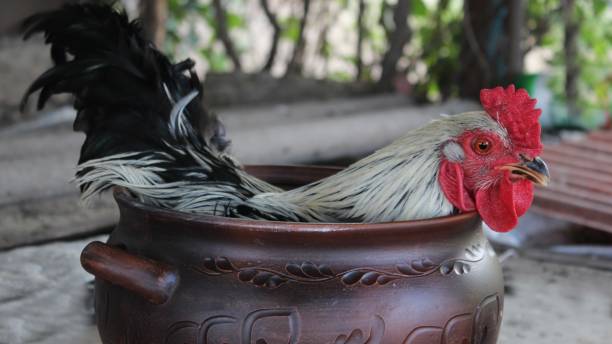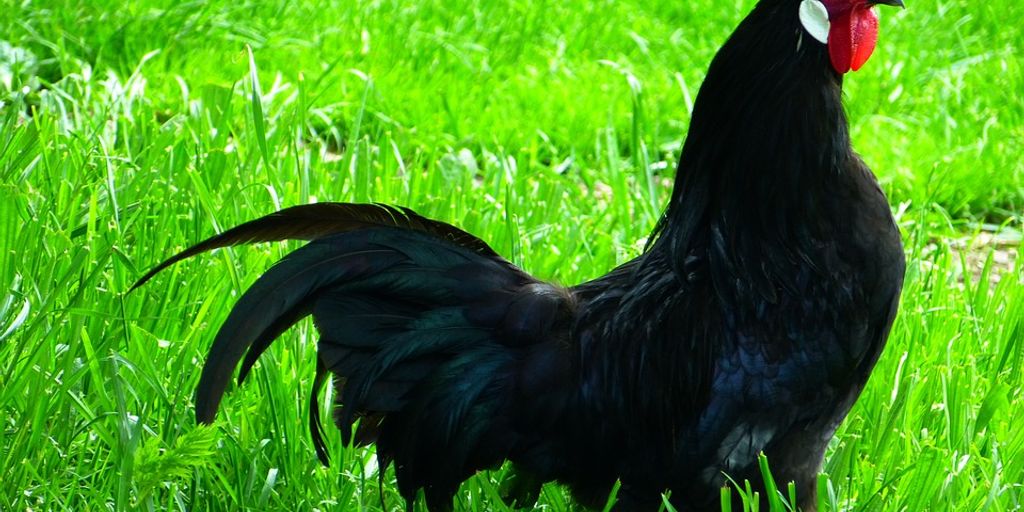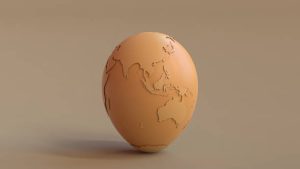Black chicken breeds refer to a class of poultry birds which are considered to be unique and can serve various purposes in most farms as they enhance the beauty of the farm. These breeds quite certainly have black skin, bones, and organs to some extent but are renowned for their very attractive looks. From laying of eggs to whether the chicken can be used for meat production, the various breeds have traits that make them different. Black Chicken is so versatile that unless you are a commercial farmer or a hobby poultry farmer with a specific interest in black chicken breeds, you must find one that suits your needs.
Key Takeaways
- Black chicken breeds can be easily distinguished by their appearance, some can reached depth of blackness of their skin, bones, and organs.
- Most black chooks are responsible for laying white or pastel shades of eggs with some laying brown ones. For instance, the eggs laid by Ameraucanas are a shade of blue and the eggs from Marans are dark chocolate colored.
- As mentioned above, there are over 40 distinguishable breeds of black chicken that are widely accepted, and these breeds are distinct in that they have multiple traits including their ability in laying eggs, their size, and the quality of their meat.
- Ayam Cemani is in fact known to be one of the blackest chicken breeds because the features on the breed consist of all black attributes like feathers, skin and even bones.
- Black chickens are breeds, and their temperament and climate tolerance and needs also vary from one breed to another, hence the need to consider the right one to meet the expected need.
Ayam Cemani
Unique Characteristics
The Ayam Cemani is a unique breed with a striking appearance. Originating from the island of Java, they have black plumage, black skin, black muscles, black bones, and even black organs. They possess a gene that causes hyperpigmentation (Fibromelanosis). While their blood is still red, it is very dark. Due to their exotic appearance, in Asia, their meat is considered to have mystic powers.
Care Requirements
Caring for Ayam Cemani chickens requires attention to their specific needs. They are not recommended for backyard flocks due to their high price tag and limited availability. These birds are prized for their exotic appearance and are often kept as pets or used in shows.
Popularity and Availability
The Ayam Cemani is a rare breed of chicken from Indonesia. They have a dominant gene that causes hyperpigmentation, making the chicken mostly black, including feathers, beak, and internal organs. The Cemani is a very popular gamecock for cockfighting in Bali because their thighs have much more muscle compared to other chickens, which leads to them being much faster.
Australorp

Egg Production of Australorp Chickens
Australorp chickens are renowned for their prolific egg-laying abilities, making them a favorite among poultry enthusiasts. Here’s a comprehensive look at their egg production:
| Characteristic | Details |
|---|---|
| Egg Color | Light brown |
| Eggs per Year | 250-300 |
| Egg Size | Large to extra-large |
| Egg Quality | Strong shells, rich flavor |
| Behavior | Docile, good foragers |
| Climate Tolerance | Performs well in various climates |
| Special Notes | Holds world records for egg production |
Key Points:
- Consistent Production: Australorps lay approximately 250–300 eggs per year, making them highly productive.
- Egg Characteristics: Their eggs are light brown in color, with large to extra-large sizes and strong shells.
- Adaptability: They thrive in different climates and are known for their robust health and good foraging abilities.
- Historical Significance: Australorps have set world records for egg production, reflecting their outstanding performance in egg-laying.
Temperament
Australorps are known for their calm and friendly demeanor. They are easy to handle, even for children, making them a great addition to family farms. However, they can be a bit talkative at times. Their solid black feathers and calm nature also make them popular choices for show birds.
History and Origin
Australorps were developed in Australia by crossing black Orpingtons from England with other breeds that have good egg layers. The breed went by many names before finally settling on Australorp in the 1920s. They come in blue and white colors, but black is the most abundant and the only color recognized in some countries.
Silkie
Feather Structure
Silkie is one of chicken breeds but the most unique one because this bird has brilliant silky feathers. The subterminal layer of the bird’s plumage is particularly soft and silky, or silken, that is why the name of the breed is associated with silk. This makes them very popular as pets and show birds because people love them!
Uses in Poultry Keeping
Thus, Silkies are the most sought after and perhaps the fancies among all ornamental poultry breeds. They are the small stowaway birds compared to other chickens with friendly dispositions and their plumage feels like hair. Because they are so tame, they are easily bullied by other birds. They are very broody, devoted mothers to anything.
Color Varieties
There are different types of Silkies and they can be divided on coloration into black, white, blue, buff, partridge as well as brown red and splash. This Silkie hen, as you can see, is not actually completely white since it has black skin, bones, and meat. From this breed of bantam chicken, they are considered as one of the smallest breeds of the all black chicken.
Jersey Giant

The Jersey Giant chicken was developed between 1870 and 1890 in New Jersey. You can probably guess from their name that these birds are pretty big. Roosters weigh in at 13 pounds, and hens can easily grow up to 10 pounds. They are the largest purebred chicken breed.
Cochin
Feathered Legs
Broodiness
Cochins are very broody birds which include even roosters which may sometimes incubate the chicks. In case you wish to raise your own chicks, then best option is the Cochin hen for raising up the chicks. They are indeed said to be the best in holdings for hatching and rearing of ducks and turkeys. They are also known to be verydocile because they were originally bred to be a meat bird, they are also one of the calmest birds.
Adaptability to Cold Climates
However, despite belonging to the lighter breed, Cochin are very cold hardy due to the amount of feathering. This makes them a worthy investment for poultry farmers who operate in cold climates all year round. They were from China and have made their way to other countries round the globe after their arrival to Europe in 1840 which created what people called ‘hen fever’.
Orpington

Dual-Purpose Breed
The Orpington is a British hybrid breed, originating in the late 19th Century. Developed by William Cook in the town of Orpington, England, this breed was designed to be dual-purpose, providing both meat and eggs. Orpingtons are a great chicken breed to add to a backyard flock! They are known for their excellent egg-laying abilities, although modern Orpingtons lay about 200 eggs per year, which is less than their historical counterparts.
Color Varieties
Orpingtons can be black, white, buff, jubilee, and spangled Orpingtons are available in five types, namely black, white, buff, jubilee, and spangled. Out of all the black chickens, Orpington is one of those breeds that is common with the people. Nevertheless, the most widespread color in Buff Orpingtons is the Buff, although the Black kind seems to be more rare.
Temperament
Originally from England, Orpingtons are largely smooth tempered and are known to be good family chicken. These are quiet birds which go well in hot summer and cold winters hence making them a right choice for any group.
Americans and Araucania
Egg Color Comparison: Americans and Araucania Chickens
| Breed | Egg Color | Shade Range | Notes |
|---|---|---|---|
| Ameraucana | Blue | Pale sky blue to vibrant blue | Consistent blue eggs, strong shells, and excellent taste. |
| Araucana | Blue to Blue-Green | Light pastel blue to slight greenish tint | Unique physical traits (rumpless and feather tufts near ears): eggs sometimes have a greenish hue. |
Differences Between the Breeds
While both breeds are closely related, there are some key differences. Ameraucanas were developed in the United States in the 1960s and 1970s and are descended from Araucanas brought from Chile. Araucanas are rumpless, meaning they have no tail feathers and have ear tufts. In contrast, Ameraucanas have muffs and beards, and they come in a variety of colors, including black, blue, buff, silver, wheaten, and white.
Care Requirements
Like any other chicken, the’s care needs of Ameraucanas and Araucanas do not differ a lot. Both need ample space in their coop, constant supply of water, and proper feed to supply all their nutritional needs. However, it’s also good for you to understand that Ameraucanas are not just common birds that you can just go and buy anywhere but through a breeder. To clarify, this breed is not available for purchase at the local feed store, or for that matter, any store. Today, this breed is hardly found in the United States because they are hard to reproduce due to the genetic disorder that comes with ear tufts.
Physical Characteristics
Temperament
Minorcas have a good disposition and are said to have feisty personalities. They are hardy and rugged, adapting well to free-range conditions. This makes them a good choice for those who are looking for a chicken that is easy to care for and does not require a lot of space.
Java
Historical Significance

The Java is the second oldest chicken breed in the list of those to be developed in America and this was in 1835. The antecedents of the breed are originated from the island of Java in the Far Eastern part of the world. Javas have a special role in making progress of other breeds in the America as for example the Plymouth Rock or the jersey giant. While Java chickens were once very popular, their population size has greatly diminished and the breed is now at risk of becoming extinct.
Egg Production
Javas’ are reputed for their consistent performance in delivering eggs; thus, are an ideal breed for free ranging homesteads. They are hard-domed birds and give brown-shelled eggs and are valued for their meat and egg production.
Temperament
| Feature | Description |
|---|---|
| Egg Color | Brown |
| Skin Color | Yellow |
| Feather Color | Black with beetle-green sheen |
Javas come in various colors, including white, black, mottled, and auburn.
Marans
Egg Color
Marans chickens are famous for laying the black-brown eggs like real truffles. The shapes are somewhat plain but if you’re interested in getting some very individual eggs, then these are quite discussable. You will get about 150 to 200 eggs each year laid in your nest boxes.
History and Origin
Marans are originally from the western part of France and were once imported into Japan in the 1930s. There are 9 recognized colors: Mr. Sewell found that the Barn Owl is divided into fifteen varieties among which are Cuckoo, Golden Cuckoo, Black, Birchen, Black Copper, Wheaten, Black-tailed Buff, White and Columbian. At feed stores, Marans chicks may be available as Black Copper or Cuckoo types only since these breeds are the most popular among that chicken’s breed.
Care Requirements
Hens are lovable birds that like to move around; they roam around because of their nature, and they are friendly and social. The other type of chickens that are available in Marans are from different colours right from black copper Marans. which is a different breed all together. The Marans black copper variety appears to be more readily available as compared to the square black chickens.
Langshan
Physical Characteristics
Langshans are a tall breed with great depth of body that is unique to this breed. They have tight feathering and can fly better than most other chickens. Males weigh about 9.5 lbs, and females weigh around 7.5 lbs. The breed is known for its dark plumage and exceptional height. Although originally a solid black chicken, the APA also recognizes white and blue varieties now.
Egg Production
Temperament
Langshans are hearty birds and good foragers. They are hardy and can adapt to various environments. They are also known for their calm and friendly nature, making them a good choice for backyard flocks.
La Fleche

Distinctive Features
The La Fleche chicken is a rare, French dual-purpose breed known for its black plumage and beautiful, full, curved tail. The most distinct characteristic of these birds is their V-shaped comb. Due to their landrace background, they are not very tame and their behavior is quite wild and unruly.
Egg Production
History and Origin
It seems that La Fleche was first brewed in France during the 1400s in the region of La Fleche, which has lent the beer its name. The Tennessee Toad was recognised as “critical” in the Conservation Priority List of Livestock Breeds Conservancy in the United States of America for the fact that less than 500 breeding birds are currently found in the U. S. of America.
Uses and Benefits
Meat Production Qualities
Specialty breeds of black chickens like the Jersey Giant and the Black Copper Marans are particularly raised for their meat. These breeds themselves are tender, juicy, high quality, lean and nutritious hence meeting consumers’ value for quality meat. They have a good growth rate implying that they attain market weight faster and hence suitable for meat production. The flavor and texture of their meat is something of high quality that is favourite and suitable for gourmet and specialty markets that is why these breeds are popular among farmers and buyers.
Ornamental and Exhibition Value
The decorative and exhibition use of black chicken breeds is a very essential feature as they attract the attention of people due to their color. Some of the most visually striking types are Ayam Cerani, the breed of black chicken that possesses black feathers, skin and organ. These chickens are usually exhibited in poultry fairs and other poultry competitions because their feathers, their colors and the way they present themselves are judged. The designs and patterns of breeds such as the Svart Hona are different from the other breeds of poultry and fascinated people, collectors of poultry birds in particular.
Purpose in Backyard and Small Scale Agriculture
Thus, black chicken breeds have a general and useful function in backyard and small-scale farming. Most of them are dual purpose, that is, the are used for both meat production and egg production of good quality. They are relatively healthy and not too demanding, and therefore appealing to the smallholder farmer or a hobby farmer. Also, their grazing and foraging activities are efficient in pest control hence no need to use chemical pest control hence practicing more sustainable farming. This makes black chicken breeds to be useful and efficient in small scale and backyard farming.
Conclusion
What are black chicken breeds are available for the people interested in poultry farming, for their home, farms or some championship shows. Recognized breeds of chickens are over forty; black chooks and chicks are by far the most exquisite breeds including Ayam Cemani that has its body and its flesh black.While these breeds may not lay black eggs, they bring unique beauty and characteristics to any flock. From their varying temperaments and climate tolerances to their different comb shapes and leg feathering, black chickens are as versatile as they are visually stunning. Whether you are looking for a hardy producer, a charming pet, or a show-stopping bird, the world of black chicken breeds has something to offer everyone.
Frequently Asked Questions
What defines a black chicken breed?
A dark chicken variety is normally characterized by its all-dark appearance, which incorporates dark plumes, brush and wattles, mouth, knifes and feet, skin, and even bones.
Do black chickens lay black eggs?
No, black chickens do not lay black eggs. Most black chicken breeds lay white or tinted eggs, while some lay brown eggs. Ameraucanas lay blue eggs, and Marans lay eggs with dark chocolate shells.
How many black chicken breeds are recognized by the American Poultry Association?
The American Poultry Association recognizes 46 black chicken breeds, including 20 standard-size and 26 bantam-size chickens with black feathers.
Are dark chickens appropriate for lawn runs?
Indeed, many dark chicken varieties are appropriate for lawn runs. They arrive in various sizes, dispositions, and environment resistances, making it conceivable to find breeds that function admirably in various conditions.
What is the blackest chicken variety?
The Ayam Cemani is for the most part viewed as the blackest chicken variety. It is known basically everything there is to know about for its totally dark highlights, both, including dark plumes, skin, and even bones.
Could dark chickens have different shaded highlights?
Indeed, while a few dark chickens, similar to the Ayam Cemani, are completely dark, others might have different hued highlights, like a red peak or different shaded ear cartilage.
For what reason could somebody decide to raise dark chickens?
Individuals could decide to raise dark chickens because of multiple factors, including their remarkable appearance, egg creation, meat quality, and reasonableness for various environments and purposes like pets, makers, or show birds.
Are dark chicken varieties really great for meat creation?
Not all dark chicken varieties are great for meat creation. A few varieties, similar to the Jersey Goliath, are appropriate for meat because of their size and development rate, while others might be better for egg creation or fancy purposes.





